Vol 3 No. 51 TROPIC LIGHTNING NEWS December 16, 1968
Index
| Unit Page | Unit Page | Unit Page | Unit Page |
| 1st Bde 4 | 2/12 2 | 25th Avn 1 | 3/22 Photos 4-5 |
| 1/27 6 | 2/12 Photo 8 | 25th Avn 8 | 4/9 Photo 3 |
| 1/27 6 | 2/14 6 | 3/22 1 | 4/23 3 |
| 1/27 8 | 2/22 1 | 3/22 Photo 1 | 4/23 6 |
| 116th AHC 6 | 2/34 Photo 1 | 3/22 1 | 4/23 8 |
| 125th Signal 8 | 25th Arty Air 7 | 3/22 4-5 | 587th Signal 8 |
| 125th Signal Photo 8 | 25th Arty Photos 7 |
Regulars
Destroy VC Fishery
TAY NINH
- A 3d Battalion, 22d Infantry, company commander's decision to follow a hunch
and cheek out a suspicious looking trail led to the discovery of a VC fishery
capable of supplying two enemy battalions with one day's rations from a single
day's catch.
While on a search and
seizure mission eight miles northeast of Nui Ba Den Mountain, Captain Andre F.
Blackmon of Natchez, Miss., and the men of Alpha Company, 3d Battalion, 22d
Infantry, came across what appeared to be a well-traveled trail leading straight
into the heart of a thick overgrowth.
Exercising due caution, the
Regulars followed the trail until it reached a large stream. At this point both trail and stream took a sharp turn to the
right, pointing the way to an unusual sight.
"We spotted a thatched hut on stilts with an unbelievably large
bamboo fish trap complex jutting out into the stream," said Blackmon.
"The trap was at least 60 feet long and over ten feet wide.
When I waded into the water and stood beside the trap the pointed stakes
at the top were about chest high on me indicating that the trap was at least
five feet high."
The stream had been
especially diverted to accommodate the trap.
A dam was built at the far end allowing the fish to spill over into the
giant bamboo cage but making it impossible for them to swim out.
"We found quite a few fish
still in the trap and still quite alive. This
served to keep us on guard. It was
quite possible that the caretakers were still around," said Blackmon.
More surprises were still in
store for the men of Alpha Company. Further
investigation turned up thirty-three cylindrical supplementary traps four feet
high and some three feet in diameter, and over 150 fishing poles complete with
shiny new hooks and bright leaders.
While the rest of the
company was wading in the stream, one squad of Regulars was busily searching out
the thatched hut. Many eating
utensils and other household items were uncovered including some unusual lamps,
one of which was manufactured from an empty can of insect repellent spray.
Now came the task of
disposing of all of the fishing gear. "We
tried burning and then blasting the main trap but both methods were
unsuccessful. We had to resort to
manually tearing it apart piece by piece," said Blackmon.
"The smaller traps and fishing poles were easier to destroy.
We broke them apart with little trouble."
Lieutenant Colonel Alexander Hunt of Wealder, Tex., landed in his
helicopter to personally inspect the discovery.
"After examining all the facilities both Captain Blackmon and myself
agreed that the camp was currently being used by enemy forces in the area and
had probably last been staffed as recently as three or four days ago," said
Hunt. "It is very likely that the
fishery was able to supply one or possibly two battalions with rations as they
moved through the area."
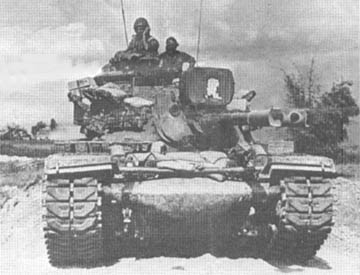 |
| MECHANICAL POINTMAN - Crewmen of the 2d Battalion, 34th Armor stay watchful as their tank leads a 4th Battalion, 9th Infantry, resupply convoy. (PHOTO BY PFC H.J. TSCHIRNER) |
25th
Avn Bn Awarded Two Unit Citations
In parade ceremonies at the
25th Aviation Battalion, Major General Ellis W. Williamson decorated the colors
of that unit with the Valorous Unit Award and the Meritorious Unit Award.
The Battalion was cited as a
valorous unit for action July 19 1966, south of the Saigon River in the Ho Bo
Woods when two infantry platoons made contact with entrenched Viet Cong forces
and called for gunship support.
Gunship crews of the 25th
(Continued on Page 8)
Triple
Deuce Finds Camp
DAU
TIENG
- Working their way through thick vegetation in the Boi Loi Woods, infantrymen
of Alpha Company, 2d Battalion (Mechanized), 22d Infantry, discovered a
company-sized enemy base camp.
The complex, consisting of a
dozen bunkers and numerous trench lines and tunnels, was found during the early
morning, shortly after the 3d Brigade soldiers left a night position 35 miles
northwest of Saigon.
They were looking for an
enemy patrol which had fired harassing shots at their position during the night.
The Triple Deuce soldiers were conducting reconnaissance in force
operations with Provincial Reconnaissance soldiers of the Army of the Republic
of Vietnam (ARVN).
The first bunker was
discovered less than 200 meters from the company's position.
As the infantrymen followed the tunnel network, they found a substantial
cache of enemy munitions.
Included were 18 rounds of
82mm mortars, six dozen 60mm mortars, an AK-47 assault rifle and 5,000 rounds of
small arms ammunition, 20 Chicom hand grenades and 60 pounds of rice.
In a small glade arranged
almost like an amphitheater, the enemy had arranged a six by eight foot sand
table on which to plot operations.
"It is obvious the Viet
Cong are devoting quite a bit of attention to our presence in this area," said
Major Kenneth Smith, 3d Brigade intelligence officer.
Joey Bishop Troupe Visits
In Tay Ninh
By 1LT Mack D. Gooding
TAY
NINH — Joey Bishop, Tippi Hedren and
Mel Bishop recently visited the troops of the 1st Brigade, shaking hands
and posing for photographs.
Leaving from Tay Ninh West
Base Camp, they flew to Fire Support Bases Bragg, Washington, Buell and Rawlins
before returning to Tay Ninh West.
The troupe ate lunch at FSB
Washington, and at FSB Buell. Joey
Bishop was made an honorary Regular of the 3d Battalion, 22d Infantry.
Battalion Adjutant Captain
Ronald C. Owens of Baltimore, Md., presented Bishop with a plaque, and Miss
Hedren and Mel Bishop with cigarette lighters bearing the Battalion crest and
inscription.
At Tay Ninh West, Bishop and
Miss Hedren visited the 45th Surgical Hospital signing autographs and talking to
the wounded.
At an appearance at Holiday
Inn, Bishop said, "When I get back to the states, I'm going to tell it like
it is."
Bishop is the star of a late
night talk show on ABC television. Miss
Hedren is a stage and movie star with, among other roles, the starring role in
Alfred Hitchcock's thriller "The Birds" to her credit.
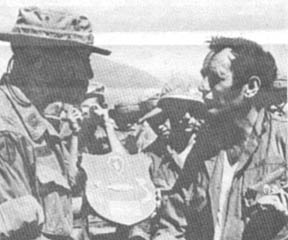 |
HONORARY
REGULAR
- (Left) Entertainer Joey Bishop is presented a plaque making him an honorary member of
the Regulars. The presentation was
made at FSB Buell by Captain Ronald C. Owens of Baltimore, Md., adjutant of the
3d Battalion, 22d Infantry. (PHOTO
BY SP4 HERB BURDETT) HERE'S JOEY - (Right) Joey Bishop gives an impromptu session of joking and posing with the men of Alpha Company, 4th Battalion, 23rd Infantry, on tour of the 1st Brigade. (PHOTO BY SP5 DON BROWN) |
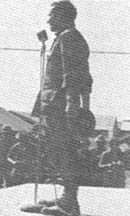 |
Page 2 TROPIC LIGHTNING NEWS December 16, 1968
Decorated
| SILVER STAR |
|
|
LTC
Alexander H. Hunt, HHC 3d Bn, 22d Inf |
WO1
James R. Jones, D Trp, 3d Sqdn, 4th Cav |
Tropic Lightning Tots
The Commanding General Welcomes
The Following Tropic Lightning Tots
To The 25th Infantry Division – As
Reported By The American Red Cross.
Born To:
| Nov
13 SP4 and Mrs. Nathaniel F. Langley, D Trp, 3d Sqdn, 4th Cav., a daughter Nov 14 PFC and Mrs. Donald W. Cochran, Co B, 2d 14th Inf., a daughter Nov 15 SGT and Mrs. Richard J. Wilcox, HHC 25th Div., a son SP4 and Mrs. James L. Miller, Co. E, 725th Maint Bn., a son Nov 24 SP5 and Mrs. Sammy N. Long, Co C, 125th Sig Bn, a daughter |
Nov
24 SP4 and Mrs. James O. Layton, C Trp 3rd Sqdn, 4th Cav, a son Nov 26 SP4 and Mrs. Ronald Bowens, 272d R.R. Co, a daughter Nov 27 SSG and Mrs. Donald L. Snavely, B Trp, 3d Sqdn, 4th Cav, a daughter Nov 28 SP4 and Mrs. Eugene W. Ziber, Co A, 25th S&T Bn, a son Dec 2 CPT and Mrs. Frank W. Clarke, Div. Surgeon's Office, a daughter |
Arty
Fields Get Distinct Insignias
Separate insignia have been
approved for the U.S. Army's two artillery branches.
Officers in the Field
Artillery Branch and enlisted personnel assigned to field artillery
organizations will be authorized to wear an insignia consisting of two crossed
field guns.
This insignia was used by
the Field Artillery Branch before January 2, 1957.
Officers in the Air Defense
Artillery Branch and enlisted personnel assigned to air defense artillery
organizations will continue to wear the present Artillery Branch insignia, which
consists of two crossed field guns and a missile.
The names of artillery
officers transferred to the new Air Defense Artillery Branch will appear on a
special order scheduled for publication in November with an effective date of
December 1, 1968.
New insignia will be
authorized for wear on effective date of the order.
Tropic
Fatigues OK To And From RVN
WASHINGTON (ANF)
- Soldiers flying to and from Vietnam on military flights soon will be able to
wear their tropical combat uniforms instead of dress uniforms for both trips.
Department of the Army
Message 885941 states that the combat tropical uniform will be worn on military
and Military Airlift Command (MAC) charter flights.
After reaching the
processing center in the United States, men returning from Vietnam will wear
either the Army Green uniform issued at the center or the Army Khaki uniform in
their possession for travel within the United States.
Malaria
Cases Make Menace
There are preliminary
indications of rising incidents of malaria among 25th Division troops.
Commanders are urged to maintain strong emphasis on personal protective
measures.
These should include the use
of insect repellent, mosquito nets, 'sleeves down at sundown' (especially
for troops in the field), and elimination of standing water.
The orange C-P pill is
required of all personnel on a weekly basis.
The white Dapsone pill
should be taken daily by troops operating above the 60th grid line and southwest
of a line from the Cambodian border through Go Dau Ha, Bau Trai and Duc Hoa.
Dapsone should continue to be taken for 28 days after the last day in
either area.
Tropic
Lightning
Combat Honor Roll
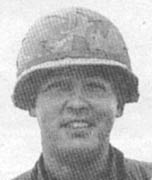 Added to this week's
Combat Honor Roll is Private First Class Edward J. Chandler of Company B, 2d
Battalion, 12th Infantry.
Added to this week's
Combat Honor Roll is Private First Class Edward J. Chandler of Company B, 2d
Battalion, 12th Infantry.
He distinguished himself by
heroic actions on October 7, 1968 while serving as a rifleman.
As his unit approached Tam
Dinh, they came under fierce automatic weapons and RPG fire from well-concealed
enemy bunkers within the village.
Chandler's squad received
a murderous barrage of fire causing many casualties and isolating the squad from
the remainder of the platoon.
With complete disregard for
his own safety, Chandler ran through the hail of bullets and tossed grenades
into the bunkers, killing the occupants.
His personal bravery,
aggressiveness, and devotion to duty are in keeping with the highest traditions
of military service and reflect great credit upon himself, his unit, the 25th
Infantry Division and the United States Army.
The TROPIC LIGHTNING NEWS is an authorized publication of the 25th
Infantry Division. It is published weekly for all division units in the Republic of
Vietnam by the Information Office, 25th Infantry Division, APO San Francisco
96225. Army News Features, Army Photo Features, Armed Forces Press Service and Armed
Forces News Bureau material are used. Views and opinions expressed are not necessarily
those of the Department of the Army. Printed in Tokyo, Japan, by Pacific Stars and
Stripes.
MG Ellis W. Williamson . . . . Commanding General
MAJ Andrew J. Sullivan . . . Information Officer
2LT Don A. Eriksson . . . . . . Officer-in-Charge
SP4 Bill Berger . . . . . . . . . . . Editor
SP5 Robert C. Imler . . . . . . . Assistant Editor
SP4 Tom Quinn . . . . . . . . . . . Production Supervisor
Page 3 TROPIC LIGHTNING NEWS December 16, 1968
Safe
Bet - Dollars To Bonds Saving Programs Make Cents
Do you plan to buy a car in
the next year or two?
If you are married, do you
plan to purchase some new furniture, or maybe a new house?
If your answer is yes,
you'll be needing a real chunk of money in the not too distant future.
Chances are quite slim that
you will win your car in a raffle, or inherit a house full of furniture.
So wise up and initiate a personal savings program.
Today's serviceman
receives more money in basic pay, special pays and allowances than ever before.
In the past six years, basic pay has been increased five times.
The trick is to save the
pain less way. Take the savings off
of the top of your income. This way
you won't miss what you don't have in your hands.
Don't kid yourself by saying that you will have some money left at the
end of the month to put into savings.
When earning power is
increased with a promotion, general pay raise or a longevity pay increase, a
certain portion of the increase should be earmarked for savings automatically.
The truth is that as a
serviceman, your savings opportunities are actually unlimited. Savings institutions where deposits are insured by the
government are offering high interest rates.
Special allotment programs
are available to you also.
Here
are a few facts about the different savings programs.
SAVINGS
ACCOUNTS
- Bank, savings and loan associations, and other insftttftutions are paying
higher interest rates today than they have for several decades.
In many cases, interest on savings deposits is compounded and paid
quarterly. You may allot part of your pay to a savings institution.
U.S.
SAVINGS BOND -
Buying Series E Bonds is probably the most popular way to save. In 1968 President Johnson boosted the interest rate on Bonds
to 4.25 percent. Bonds purchased
since December 1, 1965 mature in seven years. Originally, bonds took 10 years to
mature.
You can save regularly
through the payroll savings plan, with an allotment of a part of your monthly
pay. The minimum monthly allotment
is $6.25, which pays for a twenty-five dollar bond every three months.
FREEDOM
SHARES
may be purchased in conjunction with bonds.
They pay five percent and mature in four and a half years.
THE
UNIFORMED SERVICES SAVINGS DEPOSIT PROGRAM
offers a terrific savings opportunity to every member of the Armed Forces
serving overseas. It pays interest
at the rate of 10 percent per year, compounded quarterly on deposits up to
$10,000.
You may deposit in cash, or
by allotment any part of your unalloted current pay and allowances at any time.
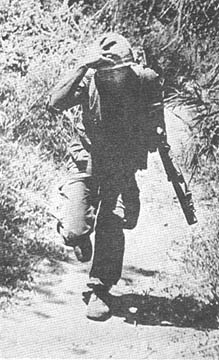 |
WASTING NO TIME getting out of the way, this Tropic Lightning soldier high tails it for cover after tossing a grenade in a VC bunker during a sweep operation with the 4th Battalion, 9th Infantry, near Trung Lap. (PHOTO BY PFC H.J. TSCHIRNER) |
Cash
For Weapons OK By Kids, Army
By
1LT Mack Gooding
TAY
NINH
- Emphasis on the Voluntary Information Program (VIP) is producing excellent
results in Tay Ninh Province for the 1st Brigade.
Under VIP, Vietnamese
civilians are paid for information of value to allied forces. Information concerning the location of VC or NVA units or
personnel, weapons or munitions, booby traps and similar data brings prompt
payment.
The program supplements a
plan under the Chieu Hoi program, which provides rewards for VC/NVA defectors
bringing in weapons.
Monetary returns can vary
from two piasters for a single round of small arms ammunition to as much as
100,000 piasters for information resulting in the capture or destruction of
artillery or large rockets in firing position.
One small boy is now 1,400
piasters richer as a result of his efforts over a three-day period.
He waved down a jeep with the 1st Brigade S-5, Major Clarence M. DeYoung
of San Diego, Calif. Said DeYoung, "He handed me a reward leaflet that I had
dropped the night before. Then he showed me two 60mm mortar rounds.
I promised to return the next morning with his reward."
Upon his return, DeYoung was
greeted by the same boy and a crowd of other small children. "This time he turned in a rocket launcher," said the
Major. "I paid him in front of
the kids, and they all scurried away, searching for more ammunition."
Later that afternoon, the
young searcher pointed out the location of two claymore mines.
"He took me on a short walk through the woods," DeYoung continued,
"and we found still more ammunition."
"By the time we left, we
had three 60mm mortar rounds, two claymore mines, and a rocket launcher, all of
which was given to a nearby Popular Forces outpost for their defense."
Additional munitions, including a 105mm howitzer round, were uncovered
and destroyed.
DeYoung stated, "The added
emphasis that the Lancer Brigade has given this program pays double dividends.
Those rounds will help strengthen a GVN outpost, and, of course, they
won't be used against allied troops. We
feel that's a real bargain."
New
Tomahawks Prove Their Skill
TAY
NINH
- It was a wet and windy November night as first platoon, Bravo Company, 4th
Battalion (Mechanized), 23d Infantry, moved out to set up their night ambush
three and a half miles northeast of Tay Ninh City.
The men of Bravo didn't
anticipate heavy action because during the past sixty days little contact had
been made. The majority of the men
were new in Bravo Company. War was
almost as foreign to them as it had been in A.I.T.
The leaders of Bravo were
anxious to see how their new men would react under fire.
It was on that November night that the veterans got to see their new
comrades work under fire.
Around eight o'clock a
listening post reported a rustling noise to their immediate front. Fifteen minutes later the Tomahawks of the first platoon
opened fire on an estimated company-sized element of Viet Cong.
The new Tomahawks directed
their fire in such a way that you would never know that it was their first time
in battle. "I was very pleased
with the performance of my men," said platoon leader, First Lieutenant Paul J.
Belzyk, of Beaver Falls, Pa.
After contact broke, Bravo
Company pulled back to a nearby Regional Forces Compound. First Brigade artillerymen then pumped in 355 rounds in and
about the contact area.
A sweep the next morning
found one dead VC, one M-2 carbine, and three blood trails. The Tomahawks suffered no casualties.
|
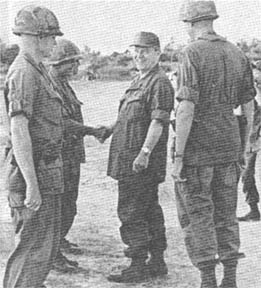 |
Page 4-5 TROPIC LIGHTNING NEWS December 16, 1968
Holiday
Inn A Welcome To Weary Field Troops
1LT
Mack D. Gooding
TAY
NINH
- Would you believe coming out of the field after 30 days and staying in a
motel?
It may be Army built and
Army run, but for tired 1st Brigade line troopers, the Tay Ninh West Holiday Inn
is the real thing.
A Holiday Inn to cater to an
infantryman's every need was the idea of the 1st Brigade Commander, Colonel
Robert L. Fair. "The combat
soldier deserves the best we can give him and the Holiday Inn will give him just
that. The Inn serves two purposes:
it will provide him facilities not available in the field and at the same time
enable him to get his equipment combat ready."
Eleven buildings, designed
like modern motels for weary travelers, will house one infantry company for two
days of rest and equipment cheeks. The facilities are much more elaborate than
those normally found in a forward base camp.
A swimming pool, an
air-conditioned TV and reading lounge, a miniature golf course, a military
affiliate radio station (MARS), live entertainment (when available) and movies
set this stand-down area apart from the equivalent set up at other base camps
throughout Vietnam.
The PX has been specially
stocked with the items that the line troopers want and need the most, and they
are given preferential treatment in the purchase of these items.
No effort has been spared to make the men's stay enjoyable and
relaxing. A steak cookout with all
the trimmings is the highlight of the first day's activities.
After the show, the men return to their new, spacious quarters and sleep
in real beds, with mattresses and sheets. The
overhead fans insure that the soldier will sleep in cool comfort.
"The purpose of the
Inn," declared Fair, "is to take 48 hours off to get their equipment back in
shape, get clean uniforms, and just get some rest.
They will be able to write some letters home and use our MARS facility to
even get a call through to their loved ones."
Of the first unit to stay at
the Inn, Fair said, "I think Delta Company, 3d Battalion, 22d Infantry, is one
of our better companies in the brigade. They
have behaved like gentlemen all the way and seem to appreciate what they have
and what they are getting. I think
the 48 hour stay of Delta Company will be very successful."
According to Lieutenant
Colonel Robert S. McGowan, brigade executive officer, "We plan on processing
two companies each week. The men will have everything they could possibly want
or need. In addition to a barber
shop and miniature golf and other diversions, they will also have a
representative from the Red Cross, a chaplain, a legal officer, finance
specialists and administrative clerks at their disposal throughout their stay.
In this way, we can take care of any personal problem that the soldier
may have."
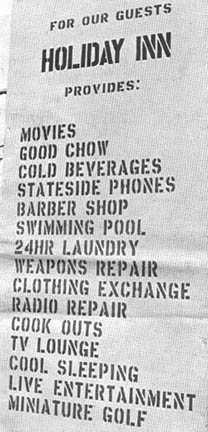 Command Sergeant Major
Robert C. Boyette said, "This is one of the finest things I've seen in my 26
years in the service. It shows that
the Army is interested in the line trooper as something more than a statistic
and more than just a machine. I
can't praise the concept enough."
Command Sergeant Major
Robert C. Boyette said, "This is one of the finest things I've seen in my 26
years in the service. It shows that
the Army is interested in the line trooper as something more than a statistic
and more than just a machine. I
can't praise the concept enough."
Opening the doors of the new
stand-down area for the first time on November 18, 1968, the men of Delta
Company, 3rd Battalion, 22nd Infantry, simply couldn't believe their eyes.
"It's the first time I've been really comfortable since I arrived
in Vietnam," exclaimed one trooper. "The
nurses in the swimming pool really make it seem like home," declared another.
"Where'd all this great
chow come from?"
"I'm going to write home
about this, but I'm going to wait until I have the pictures to send with the
letter. They'll never believe it if they don't see those pictures.
Whoever had this brainstorm has my vote for General of the World," said
one man.
Enlisted personnel of
Headquarters, 1st Brigade, volunteered their free time to work on the Holiday
Inn project. "Headquarters
company just did a tremendous job," proclaimed Fair.
"The troops that actually built this place were from Headquarters
Company of the 1st Brigade, and they built it after duty hours.
In other words, the day radio operators worked at night, and the night
radio operators worked during the day. The
entire communications section, the administrative people and the supply
personnel just did a magnificent job. I'm extremely proud of them."
NOW
YOU'RE IN FOR IT -
(Right) for a good time, that it.
The marquee proudly proclaims all the services offered the tired line
troops at the Inn. (PHOTO BY SP4
HERB BURDETT)
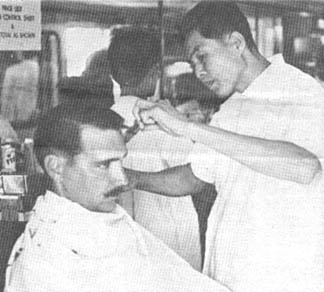 |
HOLIDAY HAIRCUT - CW2 Ronnie Robiannette of Orlando, Fla., gets his hair cut at the Holiday Inn Barber Shop in Tay Ninh. The Holiday Inn features services for relaxing line troops. (PHOTO BY SP4 DON BROWN) | |
| LATHER UP - Just in from the field, Sergeant John C. White of Roanoke, Va., heads for the shower of the Holiday Inn. White is with Co. D, 3d Battalion, 22d Infantry, the first unit to use the new rest center. (PHOTO BY SP4 HERB BURDETT) | 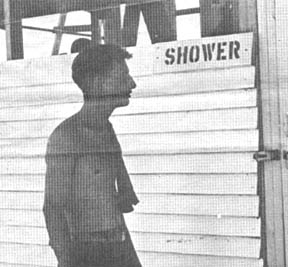 |
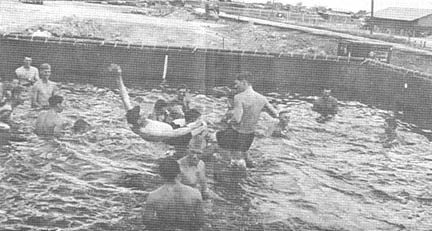 |
| SPLASHING TROOPS enjoying a stand down at the Inn find the large pool not the least of its attractions. Cavorting in a cool pool is a good way to spend a hot afternoon. (PHOTO BY DON BROWN) |
|
STEAK AND POTATOES were the order of the day when the Holiday Inn, Tay Ninh, opened its doors. Each unit that spends a few leisurely days at the Inn will find steak cooked on an outdoor grill. (PHOTO BY SP4 DON BROWN)
|
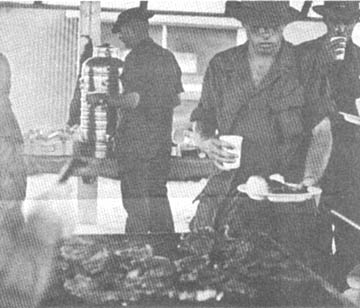 |
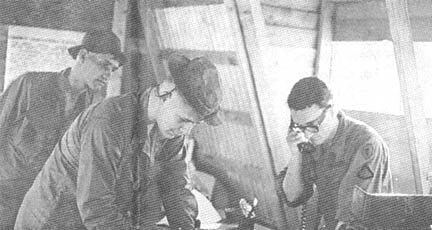 |
| CALLING HOME - SP4 Leroy Yap puts in a call to Hiku Maui, Hawaii, at the Holiday Inn MARS Station at the Tay Ninh base camp rest center. (PHOTO BY SP4 DON BROWN) |
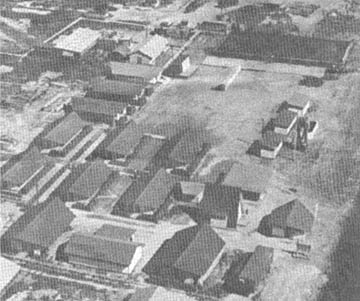 |
COMPLETED COMPLEX - An aerial view of the completed Tay Ninh West Holiday Inn shows just how extensive the facilities are. (PHOTO BY SP4 DON BROWN) |
Page 6 TROPIC LIGHTNING NEWS December 16, 1968
CRIP
Pulls A Heist, Gets Cash, Five VC
DAU
TIENG
- Springing an ambush in the Ben Cui rubber plantation 45 miles northwest of
Saigon, a 3d brigade patrol killed five enemy and snared more than 110,000
piasters (about $1,000).
The Combined Reconnaissance
and Intelligence patrol (CRIP) of the 1st Battalion, 27th Wolfhounds killed a
Viet Cong procurer who was carrying the money.
He was armed with a pistol and bore a number of documents which were
turned over to intelligence officers.
The documents revealed that
the purchasing agent, and enemy supply official was in the area to buy rice and
other supplies for enemy troops.
The ambush patrol had set
out from Dau Tieng with the intention of capturing two known members of the Viet
Cong infrastructure who live in a hamlet at the edge of the rubber plantation.
When they got near the
hamlet they set up a hasty ambush in heavy vegetation as Private First Class
Robert J. Unser of Morrisonville, III., spotted more than a dozen enemy walking
in a file toward the CRIP position.
He and Private First Class
David G. Silver of Grand Rapids, Mich., the platoon point man and machine
gunner, told the Tropic Lightning soldiers to stay down.
Two riflemen, Privates First
Class Willis Davis of Detroit, Mich., and Carl Hathaway of New Canton, III.,
opened fire as the rest of the CRIP soldiers blasted away at the Viet Cong
patrol.
"I'm proud that my men
reacted quickly to get this five body count, the money and also the documents,
which may be of some value," commented First Lieutenant Jerry Pruitt of
Osceola, Ark., CRIP leader.
Not content with the results
of the ambush, the CRIP leader and his men continued into the hamlet and
captured the two Viet Cong infrastructure members who had been their original
quarry.
| DAWN—With the sun barely above the eastern horizon, men of Delta Company, 1st Battalion, 27th Infantry Wolfhounds are already well on the way to setting up a blocking force 35 miles northwest of Saigon. They are aboard Hornet helicopters of the 116th Assault Helicopter Company. The 3d Brigade troops detained three VC suspects. (PHOTO BY SP4 HECTOR NADAL) | 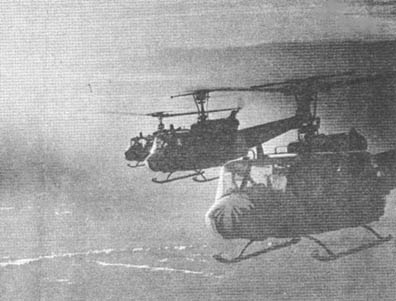 |
Tomahawks,
RVN Police Check Roads, Grab VC
CU
CHI -
Another example of co-operation between American soldiers and their Vietnamese
counterparts is taking place in the 4th Battalion (Mechanized), 23d Infantry.
Alpha Company, commanded by
Captain David D. Beach, of Chicago, has been working with a group of Vietnamese
National Policemen. The mission of
this combined force is to set up road checks.
These road checks are successful in catching draft dodgers and VC
suspects.
While on a recent road check
seven miles east of Tay Ninh, third platoon, Alpha Company, along with members
of the National Police apprehended two draft dodgers and one suspected Viet
Cong. The one suspected VC turned
out to be the real thing.
"These road checks are
very effective," said platoon leader First Lieutenant James F. Mitchell, of
Theodore, Ala.
The road checks are not only
valuable for catching VC and draft dodgers, but they have a great deal of human
interest too. Just by working
together the Americans and Vietnamese can learn much about each other.
"Even though there is a language barrier, we still manage to
communicate," commented Private First Class Jim Watkins, of Luxora Ark.
When asked how he felt about
the two forces working together, Lieutenant Colonel Albert C. Butler, of
Jackson, Miss., commanding officer of the Tomahawks said, "When two nations
are united and bound to the same
cause they have little trouble in communication and expressing their admiration
for each other."
Mess
Award For October To 2-14 Co.
CU
CHI -
During a brief ceremony in the office of Second Brigade commander, Colonel
Eugene M. Lynch, the Best Mess award for the month of October was presented to
the Headquarters Company Mess Hall of the 2d Battalion, 14th Infantry.
Sergeant First Class Johnnie
H. Malone, mess steward and Captain John Goodrich company commander accepted the
award for the second brigade unit.
Continuing a tradition begun
in Hawaii before the division's deployment, the award was based on an
inspection conducted by Fire Brigade Food Service Advisor, Chief Warrant Officer
David T. Hall, Jr.
Wolfhound
Checks Out Cache Club
DAU
TIENG
- Wolfhounds of Bravo Company, 1st Battalion, 27th Infantry, turned up a weapons
cache consisting of antitank mines, claymores, and other weapons.
The 3d Brigade soldiers were
exploring an area of deep woods, 30 miles northwest of Saigon, when they
discovered signs of recent enemy activity.
A trio of Wolfhounds were
checking out what looked like air vents. They
were Privates First Class Paul Keeler of Monroe, Mich., James Massoth of
Rockford, III., and Jackie Underwood of Carthage, Tenn.
Suddenly Keeler spotted the
entrance to a bunker complex. "I
think we've found something," he yelled to his comrades.
The Wolfhounds searched the
bunker complex ferreting out 100 welding rods and 200 feet of trip wire.
In quick order they found 1,000 blasting caps and 100 chicom claymore
mines ranging in size from 10 to 40 lbs.
Page 7 TROPIC LIGHTNING NEWS December 16, 1968
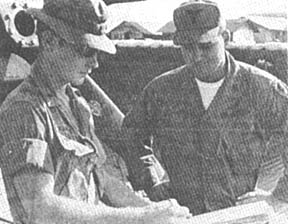 |
PREFLIGHT BRIEFING - First Lieutenant Stanton Thomas, of Lawrence, Mich., brief Army aviator First Lieutenant John Henderson prior to takeoff. |
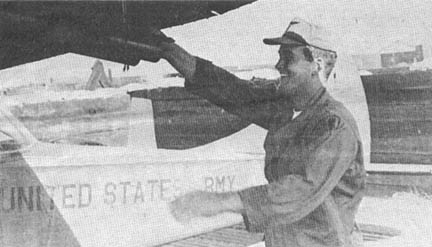 |
|
ROCKETS READY - Henderson fuses the rockets carried on the O-1 in preparation for a counter-mortar mission. The rockets mark target areas with smoke. |
Division
AO's Task Designed To Bring Smoke
By
1LT Samuel Tata
The 25th Division's
artillery air observers perform five basic missions, whose objectives vary from
adjusting artillery fire to reconnaissance of specific areas.
The U.S. Army O-1 Bird Dog
is the aircraft primarily used for these missions.
Other aircraft, including the Army's OH-23, LOH-6 and UH-1 helicopters,
are also available and used in lieu of the fixed-wing Bird Dog.
Visual reconnaissance
missions are flown for the Division Artillery S-2.
They generally consist of checking areas where reports indicate possible
enemy troop locations or recent enemy activity. The air observer looks for indications such as new trails in
grassy areas or possible enemy use of existing trails and roads.
An air observer checks the
same area on a daily basis and furnishes reports of any significant changes in
the terrain, which the S-2 shop evaluates in determining enemy troop
concentrations and movements.
Division Artillery air
observers are on a 24-hour standby for contact missions.
Any allied unit in contact with the enemy can request an air observer by
calling the Division Artillery S-3 duty officer.
Once on station over the
area of enemy contact, the air observer will coordinate with the engaged
unit's artillery liaison officer or one of his forward observers on the ground
or with the ground commander. The
location of friendly units and their movement and the placement of the desired
artillery support will be determined.
The air observer circling at
1,500 feet has the optimum vantage point of the entire friendly and enemy
situation. He can adjust fire on
stationary enemy positions or direct blocking fires to prevent enemy escape and
evasion from the pressing allied forces.
Because the air observer is
not limited by terrain features or vegetation, he is able to bring much more
timely and accurate artillery fires on the enemy than would be possible by a
ground observer.
The excellent aerial vantage
point is used again when the air observer conducts destruction missions.
These missions differ from the contact mission in that no friendly forces
are engaged with the enemy in the area at the time the air observer adjusts
fire.
Targets for destruction
missions may be enemy bunkers; tunnel complexes; trench lines; or suspected
enemy troop or supply locations along wood lines, stream lines, or any other
camouflaged positions. An air
observer's effective and accurately directed artillery fire on such targets
greatly deters the enemy from any objective he may have.
Finally, the air observers
are called upon to fly counter-mortar and counter-rocket watches.
Flying in the vicinity of a night location, fire support base, base camp,
or Vietnamese city, the air observer can readily locate enemy mortar or rocket
firing positions by observing the outgoing tube flashes.
The air observer can perform
all these missions with minimum limitation.
Although the aircraft has a fuel limitation, there is always another
aircraft and air observer standing by ready to come on station to be briefed and
continue the mission.
Problems of night
observation are overcome by the availability of artillery illumination or flare
ships that provide necessary light to continue missions during the hours of
darkness.
Thus the air observers (AOs,
or Alpha Oscars) are able to perform their direct combat support missions by
giving timely, effective, and accurate direction and adjustment of artillery
fire power whenever and wherever needed, whatever the situation.
PHOTOS BY SGT Karl Gutknecht
|
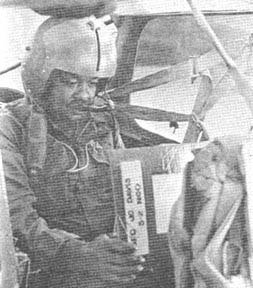 |
GRIDS PLOTTED - Sergeant First Class John C. Davis, of Cincinnati, Ohio plots grids prior to takeoff on a registration mission. Precision registration of all division artillery firing batteries is just one of the tasks of the AO. |
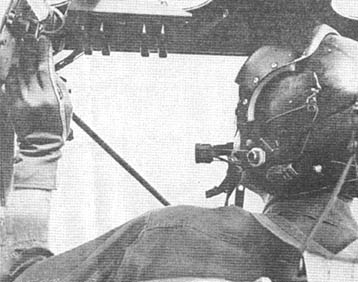 |
| CHECKING COMMUNICATIONS - Army Bird Dog aviator adjusts his radio as he communicates with an aerial observer seated to his rear. |
Page 8 TROPIC LIGHTNING NEWS December 16, 1968
Letter
Brings Clothing Tribute To SGT's Vietnamese Friends
CU
CHI -
Sometimes a letter can get a lot of action.
One letter to the people in his hometown, Parsippany Township. N.J., got
Sergeant Sam Stafford two tons of clothing for orphanages and a hospital in
Vietnam.
Stafford, like many
Americans in Vietnam, made a number of friends among the local population during
his tour. While stationed in Dau
Tieng with the 125th Signal Battalion during operation Yellowstone, he and a
young Vietnamese civilian developed a close friendship.
When Charlie, the name the
sergeant had given to his buddy fell victim to a Viet Cong terror attack near
Dau Tieng, Stafford thought there should be something he could do.
He wrote a letter to Mayor Henry Luther explaining about the death of his
friend and asked whether any of his hometown friends would like to send the
people in the Dau Tieng area gifts of clothing in memory of Charlie.
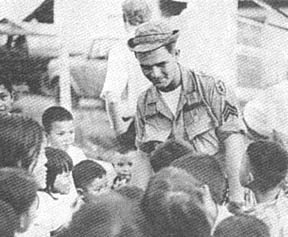 At home, the response was
tremendous. Mayor Luther read Sam's letter at a council meeting, and the local
papers carried the full story.
At home, the response was
tremendous. Mayor Luther read Sam's letter at a council meeting, and the local
papers carried the full story.
Over forty local
organizations rallied behind the project. Two
tons of clothing were bought or collected, and shipped to Vietnam for
distribution.
What originated as a
thoughtful gesture to the memory of a good friend had snowballed into a major
civic action undertaking. The
people at home had done their job and more, now Stafford had to sort the
clothing and get it to the people who could use it.
On November 1 at a
Children's Day Festival in Bao Tri, Stafford turned over about one ton of
clothing to the province chief.
FACES
TELL THE STORY
- (Above) Sergeant Sam
Stafford of the 125th Signal Battalion stands in the midst of children with
beaming eyes as he distributes clothing. The
clothing was a gift from the people of Sergeant Stafford's home town,
Parsippany Township, N.J. (PHOTO
BY SP4 CHUCK WITHROW)
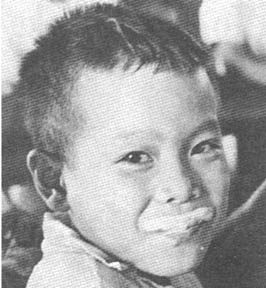 |
MUSTACHED WITH MILK - A youngster at Dau Tieng elementary school, 45 miles northwest of Saigon, brightens with a smile as other youngsters tease him about looking like an old papa-san. The milk, provided by the 3d Brigade, was distributed as part of a continuing civic action program by the White Platoon, 587th Signal Company. (PHOTO BY SP5 BILL SLUISI) |
A
Hard Day Proves Worth Of Tomahawks Young CRIP
TAY
NINH
- Combined Reconnaissance and Intelligence Patrol, better known as CRIP, is
geared for action. The CRIP of the
4th Battalion, (Mechanized), 23rd Infantry, has kept pace since it was formed
two weeks ago.
CRIP was performing lead
security on Highway 22, eight miles west of Tay Ninh City, when called into
action. At 5:30 p.m., CRIP received
word to return to Tay Ninh West to pick up ammo to deliver to Fire Support Base
Hull, sixteen miles southeast of Tay Ninh City.
At 8 p.m. just as the men of
CRIP had finished their mission, they received word that the Crusaders of the
187th Assault Helicopter Company had lost a gunship to small arms fire four
miles south of Tay Ninh City.
Without hesitation CRIP
moved into action. Braving the
night and an estimated two battalions of VC and NVA troops, CRIP went to work.
After checking out the area
completely, CRIP set up security around the fallen gunship. The night vigilance
passed without incident.
Citations.......
(Continued
From Page l)
Aviation Battalion responded aggressively engaging the hostile force, flying
fearlessly at treetop level through intense ground fire.
Despite the increasing barrage, they effectively suppressed the enemy and
prevented them from inflicting heavy losses on the American forces.
In reinforcing the troops,
transport helicopter crew braved the hostile fire and landed within 150 meters
of the line of contact.
Later, when the battalion
was requested to extract friendly forces from the battlefield, pilots maneuvered
their craft from point to point, to pick up the still savagely engaged forces
and often landed within two meters. of wounded men so door gunners could quickly
lift them inside.
The 25th Aviation Battalion
earned the Meritorious Unit Commendation during the period of April, 1966, to
December, 1967. In that period the
total dedication of the battalion earned it the respect and admiration of all
those with whom they served.
The men of the battalion
participated in all major tactical operations conducted by the maneuver
elements, and in every instance, they acquitted themselves in an outstanding
manner.
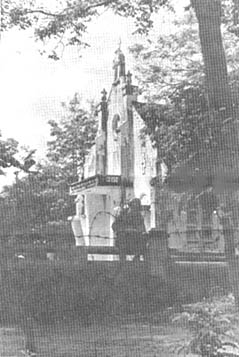 |
BARBED WIRE - Barricades and the watchful eye of an infantryman from the Tropic Lightning 2d Brigade's 2d Battalion, 12th Infantry, keep a church yard secure during regular MEDCAPs near Trang Bang. (PHOTO BY SP4 CHARLES HAUGHEY) |
Rallying
Hoi Chanh Cites Bad Chow As Big Reason
DAU
TIENG
- Editor's note: The following is an account of the rallying of a Hoi Chanh as
it was told by Specialist 4 John F. Sherwood of Portland, Maine. He is an infantryman with Alpha Company, 1st Battalion, 27th
Infantry Wolfhounds of the 3rd Brigade.
"The last time I looked at
my watch it was 1:35 in the morning. I
was on guard at the bunker line of our forward location, trying to fight off
sleep," he said. "Suddenly I
heard some sort of a babbling outside the wire.
I
put my M-16 off safe and tried to make out what was out there in the darkness.
I caught sight of a figure with upraised hands silhouetted against the
sky."
"I really thought I must
be dreaming - until I heard the words "Chieu Hoi" among the ceaseless flow
of Vietnamese words."
"Still not sure it was
real, I alerted the rest of my position and sent one of the guys after an
interpreter.
The stranger in the dark turned out to actually
be a Hoi Chanh, and we managed to get him inside the wire without any incident.
He left an AK-47 assault rifle outside the wire, and we retrieved it in
the morning."
"He deserted the Viet Cong
he confided later, because the food was terrible.
The following morning, though, what did we have for breakfast to assure
him that he'd made the right decision? S.O.S."
Thanks to
Ron Leonard, 25th Aviation Bn., for locating and mailing this issue,
Kirk Ramsey, 2nd Bn., 14th Inf. for creating this page.
This page last modified 8-12-2004
©2004 25th Infantry Division Association. All rights reserved.